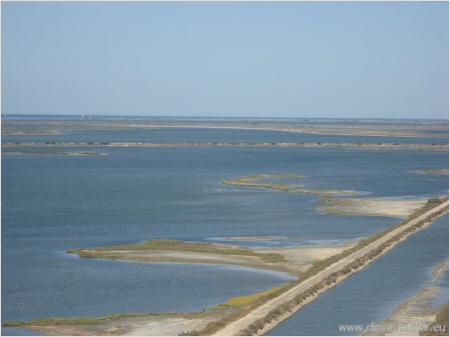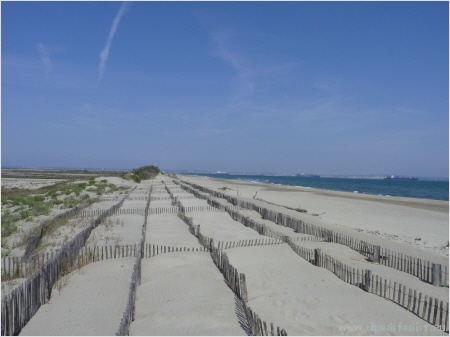Lessons Learnt
Stakeholder Involvement
The Conservatoire du Littoral is giving its lands in hands of other organizations to manage the natural sites. They “go local” and this approach helps local community to feel more concerned and involved. Local communities, and particularly hunters and farmers (rice culture, bulls …), have an important influence in the local policy concerning the management of natural areas in Camargue. A better communication is needed to be done to increase their concerns about climate change phenomenon.
Participants' reactions
If you want to protect nature and own areas, it is not necessary to do the management yourself. The Conservatoire du Littoral trusts a lot of organizations to do the management: National Park, friends of Marais du Vigueirat, different communities etc. (Nynke Van der Ploeg- Senior Ecologist & Nico Altena – Deputy Director, Natuurmonumenten, Netherlands)
“Inspired would be the best description of my mood at the end of this excellent visit. Conservatoire du Littoral […] is doing sterling work acquiring key habitats and managing them effectively both for the habitats, for visitors and as demonstration sites. (Chris Tyas, Project Manager - RSPB volunteer for National Trust, United Kingdom)
All managers of the visited areas are observing the development of their areas, mainly with monitoring activities, but valid identification of the real reasons of change is difficult. Reducing the impacts of climate change is difficult too, limited or not possible. All managers are trying to contact or involve the stakeholders into deciding processes of their areas with regularly meetings. In general networking is necessary between NGOs, stakeholders, politicians and the public. (Eva Juergens and Marianne Ludwig, NABU, Deutschland)

Coastal Management at the Etang de Vaccares
(Photo: Conservatoire du Littoral)
Let Nature takes its course
During the visit on Beauduc site, the approach of coastal management on the Etang de Vaccares, which is the largest pond in Camargue (6,500ha), has been discussed. The new adaptation strategy on coastal management implemented by the Conservatoire du Littoral in Camargue (“let nature takes its course”) appears to be quite similar than the approach from the National Trust, Natuurmonumenten and NABU (‘Mother Nature knows best’).
The experience of renaturation, on a large scale (6,000 hectares), by leaving the dike been deteriorated and allowing the marine entries was judged very positively, to restore the Camargue natural way of functioning. Scientific monitoring will be implemented to identify the positive impacts and to evaluate if it could be extended to other saline being aborted.
Participants' reactions
“The change in landscape at Beauduc was remarkable. There is a move to convert some of the area away from the artificial system currently in place by removing sea defences and thus stopping the use of pumps to bring water in and ultimately having to pump out as sea level rise affects the ability to gravity drain.” (Grant Lohoar, Countryside Manager - National Trust, United Kingdom)
Using soft techniques to reduce erosion impacts
On the site La Fleche de la Gracieuse, the problematic of sanding impacts in the Grand Port de Marseille has been presented by the Entente Interdépartementale de Démoustication (EID).
They are undertaking soft techniques used on the site (windbreak wooden fences – called ganivelles) to restore the dune. These techniques were very efficient at a large scale, and could avoid the silting of the Port Autonome de Marseille.

Fences to break the wind
(Photo: Celine Damery/CdL)
Long-term monitoring
Quantity and relevance of physical-chemical and biological monitoring incurred by the Natural Reserve of Camargue for over 30 years. This database gives an overview about the climate change phenomenon and leads to not dramatize the consequences of annual extreme weather events.
The Tour du Valat research center is measuring different aspects of the extensive estate as ornithology, plant species, hydrology, geomatics, socio-economic aspects, salt concentrations… at different scales, from local (Camargue) to regional (the whole Mediterranean area within a wetland observatory).
Limit human impacts on the environment
The policy provided by the Marais du Vigueirat (site owned by the Conservatoire du littoral) is to become eco-friendly (waste recycling, utilization of renewable energy…). The NGO “Les Amis des Marais du Vigueirat” is managing this site and has the ambitious goal of welcoming about 100,000 visitors; hence the question about compatibility between maintaining the site's biodiversity and the impact coming from such attendance. In line with this, the entrance for the visitors wanting to discover the Conservatoire du littoral sites is for free. The main purpose is to inform the largest public possible and to raise awareness about eco-responsibility and nature protection.
It is very useful to have a good example how you can live on a way with a low carbon footprint. The farm, visitor centre of Marais du Viguerat was very interesting. (Gert de Goot, Site manager - Natuurmonumenten, Netherlands)
Management of invasive species
In Camargue, site managers have to deal with the problem of non-native invasive species and try to eradicate or control them : manual removal of the Water primrose, cut of the pampas grass and baccharis, … Concerning the Louisiana crayfish, the strategy implemented is to encourage fishermen to catch them by using special nets (avoiding the capture of other species such as native turtles).
The presence of the listed species is not wholly related to climate change but it may be a factor in their survival and spread.
(Grant Lohoar, Countryside Manager - National Trust, United Kingdom)
The management regime is to undertake extensive monitoring throughout the aquatic areas to identify as soon as possible when a new species arrives. If there are indications that it is invasive immediate action is taken to remove all individuals of the population from the habitat. (Angela Cott, Property manager - National Trust, United Kingdom)
The project started in 2010 and was finished in 2012.